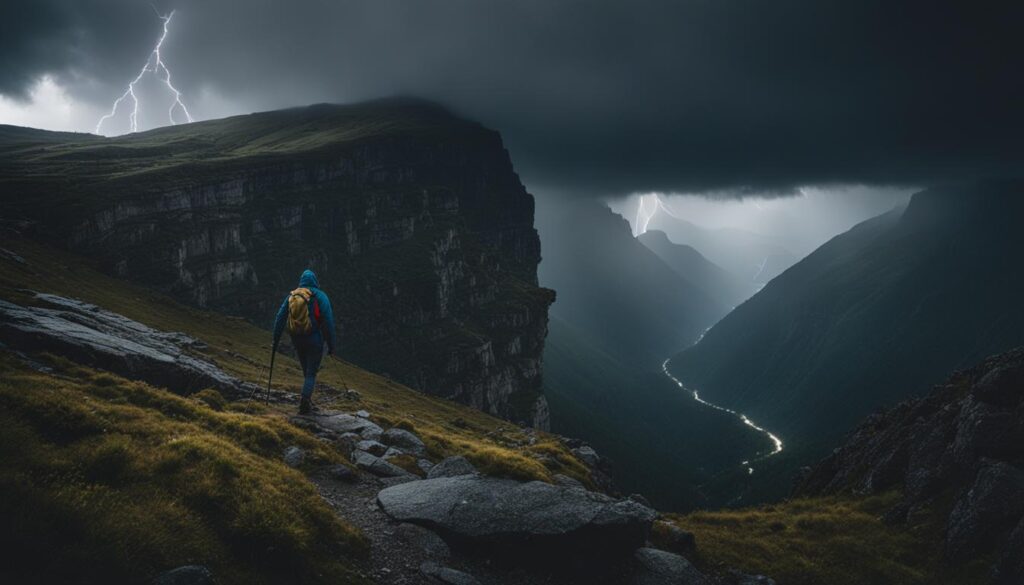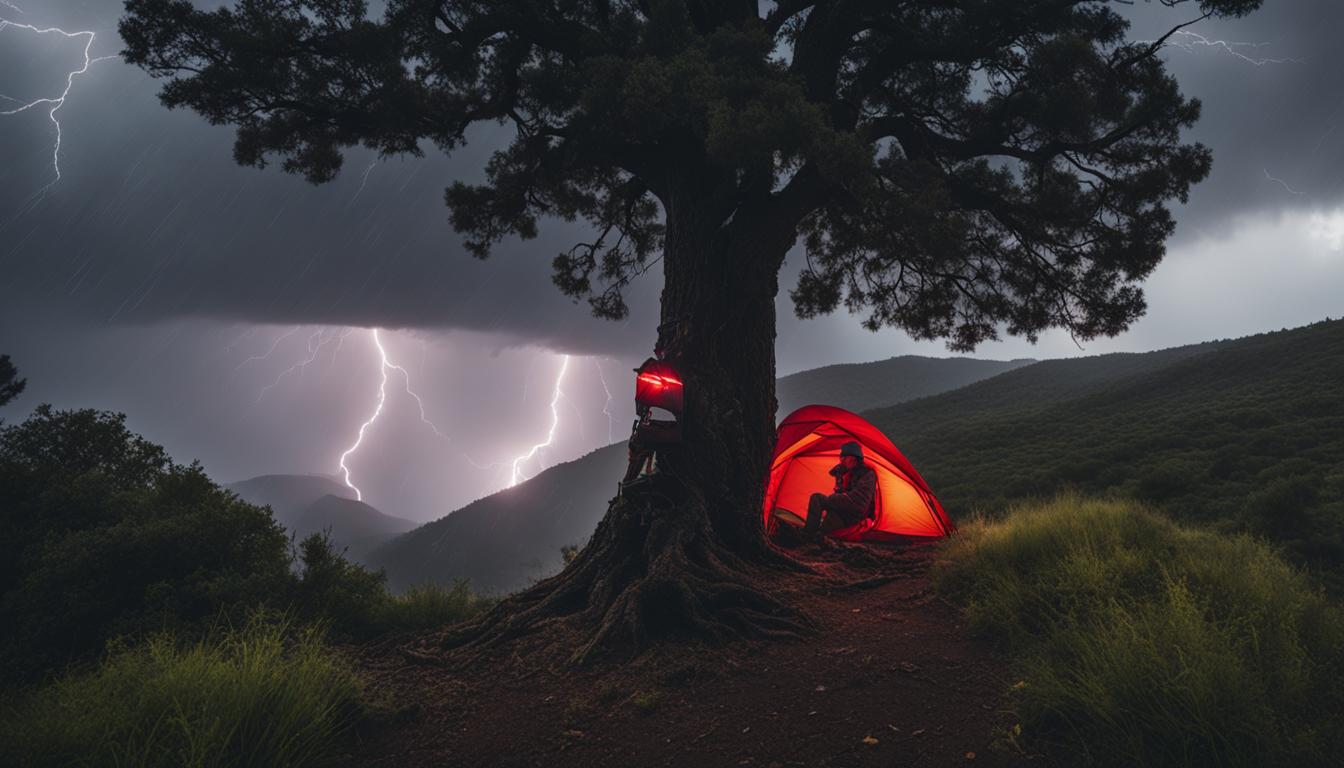When it comes to hiking, there’s nothing quite like being out on the trail, surrounded by nature’s beauty. But it’s important to remember that the great outdoors can sometimes bring unexpected challenges, including thunderstorms. Thunderstorms can be dangerous and pose a significant risk to hikers, especially when it comes to lightning strikes. That’s why it’s crucial to be prepared and take the necessary precautions to ensure your safety while on the trail.
Key Takeaways:
- Check the weather forecast before heading out on the trail.
- Seek shelter in a fully enclosed building or hard-topped vehicle during a thunderstorm.
- Avoid open areas, water, and isolated trees during a thunderstorm.
- If caught in an open area during a thunderstorm, seek shelter in a more protected area, such as a gully or forest.
- Know how to react if you cannot find shelter, including crouching down with your feet close together and avoiding lying flat on the ground.
Prepare Before Heading Outside
When it comes to trail safety in stormy conditions, being prepared is key. Before heading outside for a hike, always check the weather forecast in your area. Keep an eye out for any storms or signs that indicate the development of thunderstorms. This will help you make an informed decision about whether it’s safe to proceed with your outdoor plans.
If a thunderstorm is approaching, it is crucial to take immediate action. One of the first steps you can take is to descend from ridges, peaks, and elevated areas. By moving to lower ground, you can significantly reduce your risk of exposure to lightning. It’s also important to note that in mountainous regions, thunderstorms tend to occur in the early afternoon. With this in mind, it’s best to plan your hike early in the day and aim to be down the mountain by noon.
Remember, appearances can be deceiving. Even if the sky near you appears clear, if you can hear thunder, you are already in danger. Seek shelter in a fully enclosed building with electricity and plumbing, or a hard-topped vehicle. These structures provide the safest protection from lightning strikes. Avoid seeking shelter in partially open structures like trail shelters, tents, or open garages, as they do not offer adequate safety during thunderstorms. If suitable shelter is not available, seek protection in a valley or depression in the terrain while avoiding isolated trees or other tall objects. It is also important to keep a distance of at least 100 feet between each person if hiking in a group to minimize the risk of lightning-related accidents.
| Trail Safety Guidelines |
|---|
| Check the weather forecast before heading outside. |
| Descend from ridges, peaks, and elevated areas if a storm is approaching. |
| Seek shelter in a fully enclosed building or a hard-topped vehicle. |
| Avoid partially open structures like trail shelters or tents during thunderstorms. |
| Seek protection in a valley or depression in the terrain. |
| Maintain a distance of at least 100 feet between each person when hiking in a group. |
Reacting During a Thunderstorm

When caught on the trail during a thunderstorm, it is crucial to know how to react in order to minimize the risk of lightning strikes. Here are some important guidelines to follow:
Seek Shelter in a Protected Area
If you find yourself in an open area such as a summit, high meadow, or lake, it is important to seek shelter in a more protected area. Descend into a gully or valley instead of staying on a ridge, as these elevated areas increase the risk of lightning exposure. Shallow caves or picnic shelters are not safe options, as lightning can still pose a danger. Entering the forest can offer some protection, but be cautious not to choose the tallest tree in a stand of trees for shelter.
Avoid Water and Isolated Trees
During a thunderstorm, it is crucial to avoid water and isolated trees, as they increase the risk of lightning strikes. Water bodies and tall objects like trees can attract lightning, making them dangerous locations to be in. If suitable shelter is not available, crouching down with your feet close together is recommended. This posture reduces your overall height and minimizes the risk of a direct lightning strike. Avoid lying flat on the ground, as it creates a larger target for lightning.
Be Cautious in Tents and Vehicles
If you are hiking with a tent, it is advised to get out of the tent during a thunderstorm. The metal tent poles can attract lightning, increasing the risk of a strike. If you are near your vehicle, get inside and roll up the windows; however, avoid touching any metal surfaces as it can also increase the risk of injury. It is important to stay away from metal gear and maintain a safe distance from others in your group.
Remember, lightning safety while hiking is paramount. By knowing how to react and taking the necessary precautions, you can stay safe on the trail even during bad weather conditions.
Conclusion
Staying safe in bad weather is crucial when hiking on the trail. As I’ve outlined in this article, there are several steps you can take to ensure your trail safety in stormy conditions. By being prepared and informed about the weather forecast, you can make better decisions about when to hike and when to seek shelter.
Remember, thunderstorms can be unpredictable, so it’s important to prioritize your personal safety. Seeking appropriate shelter or protection is essential during a thunderstorm. This can include finding a fully enclosed building, a hard-topped vehicle, or a valley in the terrain while avoiding tall objects that could attract lightning.
To stay even more prepared, I recommend staying informed about lightning safety guidelines provided by organizations such as the NOAA Lightning Safety website and the National Lightning Safety Institute. Having a NOAA Emergency Weather Broadcast Radio for updates and alerts can also be beneficial.
So, before you head out on your next hiking adventure, take the necessary precautions and stay safe in bad weather. Remember, it’s better to be overprepared than caught unaware by a thunderstorm. Happy hiking!
How Can I Stay Safe During Thunderstorms While Backpacking?
When backpacking, it’s essential to follow backpacking safety tips to stay safe during thunderstorms. Keep an eye on the weather forecast, seek shelter in low-lying areas, and avoid isolated trees. If caught in the open, crouch down on the balls of your feet to minimize contact with the ground.
FAQ
How many people are struck by lightning each year?
Each year, about 300 people are struck by lightning.
How many deaths occur from lightning strikes annually?
On average, there are 82 deaths per year from lightning strikes since 1959. However, in the past 5 years, the number of lightning-related deaths has been declining, with no more than 50 deaths per year.
What time of day do thunderstorms typically occur in mountainous regions?
Thunderstorms typically occur in the early afternoon in mountainous regions.
What should I do if I hear thunder while hiking?
If you can hear thunder, you are in danger, even if the sky near you appears clear. It is recommended to seek shelter in a fully enclosed building with electricity and plumbing, or a hard-topped vehicle.
Are partially open structures like trail shelters safe during thunderstorms?
No, partially open structures such as trail shelters, tents, and open garages are not safe during thunderstorms. It is best to seek a fully enclosed building for shelter.
What should I do if suitable shelter is not available during a thunderstorm?
If suitable shelter is not available, seek protection in a valley or depression in the terrain while avoiding isolated trees or other tall objects. Ensure that any metal gear is at least 100 feet away from you, and if hiking in a group, maintain a distance of at least 100 feet between each person for added safety.
What should I do if I am caught on the trail during a thunderstorm?
If you find yourself in an open area like a summit, high meadow, or lake, seek shelter in a more protected area such as a gully or the forest. Avoid choosing the tallest tree in a stand of trees for shelter. If no shelter is available, crouch down with your feet close together. If you have a foam pad, you can stand on it to reduce the impact of ground current. If you are in a tent, it is advised to get out, as the tent poles can attract lightning. If near your vehicle, get inside and roll up the windows, but avoid touching any metal.
How can hikers stay safe during thunderstorms while on the trail?
Hikers can stay safe during thunderstorms by checking the weather forecast before heading outside, seeking appropriate shelter or protection, and knowing how to react during a thunderstorm. It is also recommended to stay informed about lightning safety guidelines and resources provided by organizations like the NOAA Lightning Safety website and the National Lightning Safety Institute. Having a NOAA Emergency Weather Broadcast Radio for updates and alerts can be beneficial as well.

